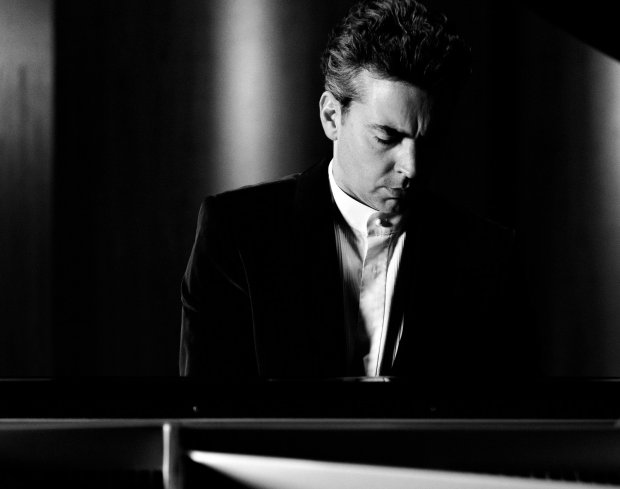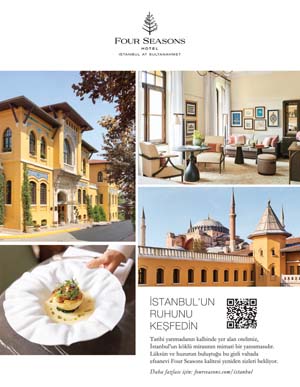The series of Istanbul Recitals for 2018-2019 at The Seed (the concert hall attached to the Sakıp Sabancı Museum in Emirgan), continued with a demonstration of pianistic prowess by the Croatian pianist Goran Filipec on Friday March 15. This was, in fact, Hungary’s National Day, the occasion on which Magyarország – as the Hungarians themselves call their country – remembers its failed attempt in 1848 to achieve independence from Austria. The coincidence was rendered even more significant by the fact that Mr Filipec’s programme consisted entirely of works by, or inspired by, the Hungarian composer Franz Liszt.
Both Franz Liszt and Lajos Kossuth, the leader of the Hungarian Revolution and thus a national hero (Bela Bartók wrote a symphonic poem in his honour), have connections with Turkey – Liszt because he visited Istanbul in 1847 to give concerts (Sultan Abdülmecid sent an emissary to meet his ship at the quayside and haul him off to the Imperial Palace to give a recital without even giving him chance to unpack his bags), and Kossuth because after the failure of the revolt against Austrian rule, he took refuge in Turkey. In September 1848, inspired by the Austrians, who were understandably miffed by Kossuth’s exertions, Croatia dispatched an army to crush Hungary’s independence movement. This fact, however, did not seem to have deterred the Croatian Mr Filipec from devoting his entire programme to the works of a Hungarian. But more of these historical connections anon.
Goran Filipec, born in 1981, seems to have absorbed quite a number of European musical and pianistic traditions. Having begun his career in Croatia, where he studied at the Ino Mirkovich Music Academy in Lovran (licensed, apparently, by the Moscow Conservatory), he then engaged in further studies at the Hochschule für Musik in Cologne, the Oxana Yablonskaya Piano Institute in Tuscany, the Moscow State Tchaikovsky Conservatory, the Royal Dutch Conservatory in The Hague and finally two institutions in Paris – the Conservatoire National Supérieur de Musique et de Danse and La Sorbonne.
His programme began with two pieces from Suisse, the first of the three volumes of Liszt’s Années de pèlerinage (‘Years of Pilgrimage’). Suisse was written around 1835-1838, revised in 1848 or shortly thereafter, and finally published in 1855. First, we heard Les Cloches de Genève (‘The Bells of Geneva’), a nocturne composed to celebrate the birth in this city of the composer’s first daughter by Marie d’Agoult – the countess who had eloped with him, leaving behind her the granddaddy of a scandal in Paris society. An article by Georg Predota on the Interlude website tells the story of the arrival on the scene of George Sand with her ‘travelling companion’ Major Adolphe Pictet, the tour of Switzerland on mules that the two couples made together, and the subsequent ructions on their return to Paris (George Sand apparently fancied Marie as well as Franz). Predota informs us that ‘Franz tried to keep the peace, with everybody – including Frédéric Chopin – predictably coming to the conclusion that it had all been Liszt’s own fault anyway.’ It was quite a come-down for Franz, who had been considerably uplifted by the tour. On the party’s arrival in Chamonix he had filled in the hotel registry as follows: ‘Place of birth – Parnassus; Profession – Musician/Philosopher; Coming from – Doubt; Journeying towards – Truth.’
But to leave the couples happily bickering and return to the concert, as soon as Mr Filipec touched the keys it became evident that he is a pianist who has the gift of making it all look easy. His technique had me goggling in disbelief, wondering how he could possibly achieve that degree of accuracy with so little seeming effort. As time went on I came to realise that Goran Filipec is by no means a one-trick pyrotechnician, confined to an all-Liszt repertoire by lack of musical imagination. He has a degree of sensitivity that would allow him to expand into many other areas, and I would certainly be more than willing to hear him do just that.
A minor interruption occurred halfway through the first number, when a member of the audience saw fit to allow some electronic device to begin emitting a bleeping noise, but that soon stopped. In fact, I must say that apart from this regrettable incident, audience behaviour at this concert was impeccable. The performer was allowed play his pieces without interruption, receiving applause only when he himself indicated that he wished to do so by rising from his seat.
Les Cloches de Genève was followed by Vallée d’Obermann – which had in fact been one of the items on the programme of Andrew Tyson, the performer for the February edition of the Istanbul Recitals. This is an attractive piece with (unusually for Liszt, I have to say) quite a catchy tune to it. The first half of the recital concluded with Après une lecture du Dante – Fantasia quasi Sonata (sometimes called the ‘Dante Sonata’) from Italie, the second volume of Années de pèlerinage. In a critique by Blair Johnston the work is criticised for its ‘indefensible length’ and the ‘overdrawn nature of its bombastic conclusion’. Liszt fans will no doubt disagree.
I should make it clear at this point that the reason why the videos I have chosen to illustrate the works in Mr Filipec’s recital are almost all by other pianists is that the great majority of his performances available on YouTube are badly recorded, and I do not wish readers to have to listen to him in recordings that appear to have been made with the microphone sitting at the wrong end of an 18ft cardboard tunnel, with the result that the sound quality is gruesome – ‘GrueTube’, in fact. Anyway, here is a performance of Les Cloches de Genève by the Russian-Jewish pianist Lazar Berman (1930-2005), a pianist I greatly admire, accompanied by the score.
And now another performance by Berman, this time of Vallée d’Obermann.
An aside: Lazar Berman, who had already been extensively persecuted by the Soviet authorities, blotted his copybook conclusively in 1980 when, on his return from a concert tour of the West – one of the rare occasions on which he was allowed out – KGB watchdogs discovered forbidden American literature in his luggage. (Being Jewish didn’t help, no doubt.) When I myself crossed the border from Turkey into Soviet Armenia at the remote frontier post of Doğukapı in 1976, having arrived by train from Kars, a grim-faced Russian official seized upon my copy of the Tao Te Ching, which had a picture of an ancient Chinese sage on the cover. He then proceeded to leaf through the offending volume with melodramatic suspicion, holding it at arm’s length and occasionally darting disapproving glances at me with his steely blue eyes. He could not understand why I was so amused. My lack of contrition only served to wind the poor man up even further, of course, but even so I could not suppress my giggles: he was holding the book upside down.
Finally, here is Lazar Berman in a highly dramatic performance of Après une lecture du Dante.
My apologies, once more, to Goran Filipec: if videos of him of acceptable quality had been available, I would of course have used them in preference to any other.
During the interval, my companions and I took to the terrace outside the concert hall for a few minutes’ exposure to the viciously cold March wind. Not for nothing does the Turkish proverb say:
Mart kapıdan baktırır,
Kazma kürek yaktırır.
(‘March makes you look out of the door’ – ie, with apprehension. ‘It makes you burn your pickaxes and shovels’ – as a desperate measure, having allowed yourself to run out of ordinary fuel in foolish anticipation of warmer weather.)
None of us minded the cold, being used to inclement weather in our home climates, for our party included a half-Russian, a lady with a good deal of Tatar blood in her veins, and a Scot, as well as my Mancunian self. And I have to say that on our way to Emirgan for the concert the violence of the elements rendered our view over the Bosphorus most pleasing: in addition to the wind whipping up the spray, there was also a sea mist to add a touch of mystery to the spring evening, which was in the first grey stages of drawing in.
The second half of Goran Filipec’s recital began with Liszt’s six Grandes Etudes de Paganini, five of which are based on the Caprices for solo violin by Niccolo Paganini (1782-1840). Here, the composer takes virtuosity to an entirely new level: the pieces are of such stupendous technical difficulty as to be almost deranged. It has to be said, however, that there is little substance beneath the thick layers of decorative froth. Indeed, the lack of underlying content caused contemporary critics – justly or unjustly – to denigrate Liszt’s compositional skills, as Robert Cummings points out in his critique.
Be this as it may, the third of the six pieces – La Campanella, the ‘Little Bell’ – has always been a firm favourite, and the audience broke into spontaneous applause at the end of Mr Filipec’s rendition. (La Campanella starts at 10:40 in the following video, by the way.) The glissando octaves in the last item (which begins at 17:22) have a daredevil, stuntman quality that makes one wonder how anyone can play them without damaging their fingers. This video of the whole cycle being played by Daniil Trifonov – accompanied by the score – is refreshingly sparkly.
The recital concluded with the Variations (or alternatively, Study) on a Theme of Paganini by the Polish pianist and composer Ignaz Friedman (1882-1948). Initially, Friedman’s harmonies were a welcome change from the rather restricted diet offered by Liszt, but I soon became frustrated by the lack of any significant compositional originality, the monotony of register and the overt imitation of the Hungarian master’s pianistic style. Anyway, here is a video.
Witold Lutoslawski (1913-1994), also a Pole, did the job rather better, I feel. In the following video, Martha Argerich and Evgeny Kissin are performing his Paganini Variations for two pianos. Here, there is much more to get your teeth into, and some real variety.
Following some well-deserved applause, Goran Filipec played us Liszt’s Valse-Impromptu as an encore. Not being familiar with this piece, I was delighted to find that it has an elegance, grace and charm reminiscent of Debussy’s Arabesques. It is high time we heard something from Mr Filipec, I know, so here is a video of him playing the aforementioned work. The recording is marred, it is true, by bad sound quality and audience coughing, but at least it allows you to see his relaxed, deliberate and perfectly controlled hand movements.
Now I really must redress the balance and make at least some attempt to do justice to Mr Filipec’s superlative performances of Liszt – to the extent that YouTube permits – so here is a video of him playing a piece that was not on the programme on 15 March: the Polonaise No. 1.
Inviting Goran Filipec to play in Emirgan was definitely a good decision on the part of the organisers of the Istanbul Recitals, and once again I must express my thanks and appreciation for the sterling efforts and good judgement of Mr Mehmet Şükûn (son of the late Kâmil Şükûn, one of the instigators of the recitals) and Nazan Ceylan.
And so we take up our historical connections once more and go back in time to 1847, when Franz Liszt spent five weeks in Istanbul. He stayed in Nur-u Ziya Sokak, a side street leading off İstiklal Caddesi (then known as La Grande Rue de Péra) in Beyoğlu. The following information is gleaned from a Hungarian website in the Turkish language. For those who can read Turkish, here it is.
Liszt had in fact intended to come to Istanbul several years earlier, but was prevented from doing so by the discovery that his consort, Marie d’Agoult, was pregnant by him for the second time. His enthusiasm for visiting the Ottoman capital was partly due to the knowledge that Giuseppe Donizetti, elder brother of the celebrated opera composer Gaetano, was employed as director of the Mızıka-ı Hümayun, the Imperial Palace’s Musical Ensemble, and Liszt wished to meet him. The opportunity finally came in 1847, when thanks to the mediation of the poet Alphonse de Lamartine he succeeded in getting himself invited to Istanbul by Mustafa Reşid Pasha, the grand vizier. Waiting for him on the quayside on his arrival from Galati (now in Romania) was Baron Resta, the Sultan’s Chief Translator, and without further ado he was whisked off to the old Çırağan Palace.
Here he found the Sultan (a devoted fan of Western classical music) eagerly awaiting him, and the Imperial instrumental ensemble and chorus ready to do their stuff: His Imperial Majesty Sultan Abdülmecid Khan wished to know what his distinguished guest thought of their abilities. After the performance Liszt expressed polite appreciation, and in doing so apparently bowed his head so low that he got a crick in his neck. The Sultan then invited him to play on an Erard piano that had been made ready, and though the maestro had been allowed no chance at all to recover from his sea voyage (not to mention the fact that his neck was probably still hurting), he promptly obliged with a recital of his own works – including, of course, the final andante from his Réminiscences de ‘Lucia di Lammermoor’, a fantasy based on themes from an opera composed by… Gaetano Donizetti.
During all this time the Sultan’s eldest son Murad was listening with rapt attention (in July 1847 he was two months short of his seventh birthday; he subsequently became the ill-fated Sultan Murad V). Indeed, it is said that it was this experience that gave him his lifelong taste for classical music – a taste that stood him in good stead, for it helped him while away the time between 1876 (when he was deposed in favour of Abdülhamid, his younger brother) and his death in 1904. During these 28 years, all of which he spent in the rebuilt Çırağan Palace, having been imprisoned there by Sultan Abdülhamid II to prevent anyone from trying to put him back on the throne, he consoled himself by playing and composing on another Erard piano – presented to him by the manufacturers while he was still Crown Prince.
Murad had ample time to reminisce during his captivity, of course, and he well remembered how his father had been so delighted by Liszt’s playing that he had called for his narguile, and puffed away so hard that the whole room was filled with smoke.
I do not wish to conclude with a depressing tale of incarceration, however, and will finish by diverting the reader’s attention to the exhibition at the main Sakıp Sabancı Museum, to which attendees at the concert were allowed privileged access before the recital began. This exhibition, scheduled to run until April 1, is entitled The Russian Avant-Garde: Dreaming the Future Through Art and Design, and features a large number of works by Russian artists created before, during and after the Revolution of 1917. A film of Tsar Nicholas II was being shown as I walked into the first of the rooms with my half-Russian companion. He immediately remarked “Sarhoş!” (‘Drunk!’), and informed me that the Tsar was in his cups morning, noon and night.
Being a person of the ear rather than the eye, I will say nothing of what was on display save that there were quite a few items that I found most pleasing. I very much enjoyed the post-Revolution propaganda materials, and the artefacts decorated with scenes of exemplary solidity between peasants and factory workers. Also, the black-and-white films being shown were a real treat.
I will leave you with a link to Aelita: Queen of Mars, a silent film dating from 1924 by the director Yakov Protazanov. It is based on a book by Alexei N Tolstoy and has snatches of Scriabin (notably, the 24 Preludes) in its soundtrack. The heroine, Aelita, is a Martian princess – daughter of the planet’s totalitarian ruler – who finds herself caught up in a proletarian revolution (of course). The Martians’ costumes, inspired by the Constructivist movement in Russian art, are well and truly trippy. I was moved to wonder whether or not someone had slipped something naughty into Mr Protazanov’s vodka. Anyway, here is the link. İyi seyirler – Happy viewing!




_The_Golden_Horn_at_Dusk_c._1900_140_92_80.jpg)




